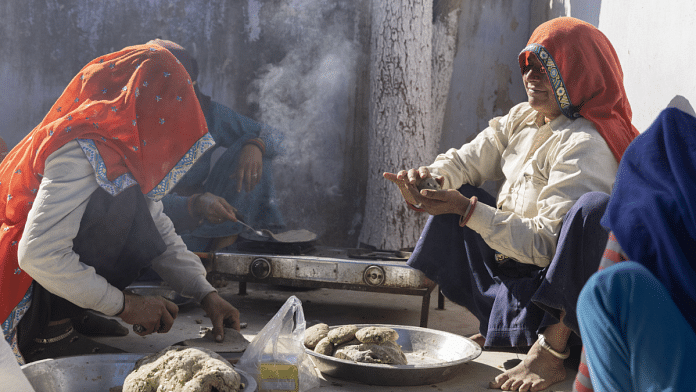M atira, an Indian wild melon, was my grandmother’s summer companion. She would slice through its pale green skin with ease, the first bite always raw, cool and sweet against the desert heat. But for her and many of her generation, this watermelon wasn’t just a refreshing treat; it was a lesson in resourcefulness.
Not a single part went to waste. If the rind wasn’t eaten fresh, it was turned into a curry or sun-dried for leaner months. The seeds were roasted and carried in kurta pockets as a quick snack.

This kind of ingenuity was once second nature in kitchens across the Indian subcontinent. Every ingredient was stretched to its fullest potential, a practice born out of necessity, but rooted in wisdom. Yet, as modern conveniences took over, such mindful consumption gradually faded, giving way to alarming levels of food waste.
While the crisis is global, its causes vary across regions. In developed nations, the issue often stems from excess – overproduction, aesthetic rejection and consumer habits. In contrast, developing nations struggle with food loss due to inadequate storage, unreliable transportation and distribution inefficiencies.
As a result, the numbers today are staggering. According to the Food and Agriculture Organization (FAO), nearly a third of all food produced for human consumption is lost or wasted annually. Meanwhile, a 2024 UN report on food security revealed that approximately 2.
33 billion people faced moderate to severe food insecurity in 2023, with over 864 million experiencing extreme shortages, sometimes going an entire day or longer without a meal. Studied together, these statistics make it clear that the issue isn’t about scarcity but distribution, consumption habits and a growing detachment from traditional food know-how. Today, food waste isn’t just an unfortunate by-product of abundance – it’s a symptom of detachment.
Across the supply chain, vast amounts of perfectly edible food are discarded at every stage. Supermarkets reject fruits and vegetables for being misshapen, too large, too small or slightly blemished. Restaurants throw away surplus food, while bulk grocery shopping often leads to ingredients expiring before they’re used.
This widespread wastage is a reflection of how modern food culture has distanced us from the effort that goes into growing, harvesting and preparing food. The convenience of abundance has made food feel disposable. The environmental cost of this waste is immense as well.
Food waste accounts for nearly 10% of global gr eenhouse gas emissions , making it a leading driver of climate change. The energy, water, and labour that go into producing food are lost when it is discarded. Studies show that over 80% of food waste occurs during production, processing, and consumption, with much of it ending up in landfills or being incinerated, both of which are environmentally damaging.
While larger geopolitical and economic policies play a role in food distribution, there is value in taking a step back and evaluating the current situation from a historical perspective. Famine, droughts, acute food shortages, economic hardships, mass migration during and after India’s independence from the British in 1947: all shaped a culture that creatively preserved, repurposed and reused every edible part of an ingredient. “Annam Brahmam”, an Indian philosophy, dictates that “food is divine” – and wasting it is akin to disrespecting god or nature itself.
Around the country, regional and local cuisine relied on every part of a fruit or vegetable to serve different functions. Every part of a banana, from the flowers, stems and leaves to peels, can be used to prepare food. Vegetable peels, like the ridge gourd, were turned into chutneys, jackfruit seeds were roasted for snacks, and even pomegranate peels were sun-dried and brewed into medicinal teas.
Day-old chapatis or wheat flatbreads would be cooked with spices again and consumed as a snack. Across south and east India, leftover rice never went to waste. In the southern states of Tamil Nadu and Karnataka, it was soaked overnight in water, slightly fermented and eaten as pazhaya saadham, a probiotic-rich dish that helps people stay cool in the heat.
In Odisha, Bengal and Assam, leftover fermented rice preparations are often a staple breakfast, paired with mustard oil, green chillies and pickles. Reducing food waste can seem like a challenge in today’s fast-paced world, where convenience often trumps sustainability. Busy schedules, misleading expiration labels and the expectation of perfect-looking produce all contribute to the problem.
However, addressing food waste doesn’t require drastic lifestyle changes, just a shift in perspective. One of the simplest solutions lies in rediscovering the resourcefulness that once defined traditional kitchens. Cooking root-to-stem, planning meals around what’s already available, and repurposing leftovers can significantly reduce household waste.
Small actions like these, when adopted collectively, can make a substantial difference. Beyond individual efforts, systemic change is also crucial. Choosing local, seasonal produce over highly packaged supermarket selections reduces waste at the source.
Supporting businesses that repurpose surplus food, advocating for restaurants to donate excess meals, and composting unavoidable scraps all contribute to a more sustainable food culture. Interestingly, the zero-waste approach that once defined kitchens in India, Africa and Latin America is now being rediscovered in the West. As movements like nose-to-tail butchery and farm-to-table dining gain traction, they mirror practices that have been second nature in many developing countries for generations.
While developed nations are turning to technology such as food waste apps and “ugly produce” markets, many developing regions are innovating within traditional frameworks. In rural India, solar drying technology is being used to preserve surplus crops, echoing age-old sun-drying techniques. Such innovations provide a modern-day opportunity to bridge traditional wisdom with contemporary solutions.
Ultimately, the goal isn’t perfection but a return to mindful eating; one that respects both the ingredients and the labour behind our food. Dipali Khandelwal, Founder, The Kindness Meal Hemlata Chauhan, Content Writer, The Kindness Meal This article is republished from the World Economic Forum under a Creative Commons license. Read the original article .
Save my name, email, and website in this browser for the next time I comment. Δ document.getElementById( "ak_js_1" ).
setAttribute( "value", ( new Date() ).getTime() );.
Environment

Zero waste served Indian-style—why the future of food sustainability lies in the past

In rural India, solar drying technology is being used to preserve surplus crops. Such innovations bridge traditional wisdom with contemporary solutions.















